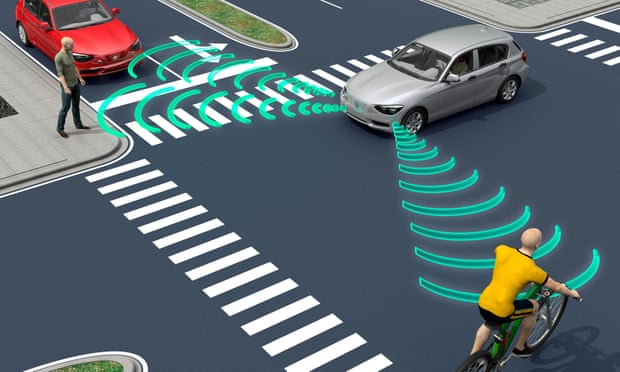
‘Smart people are trying to figure out how this works,’ the Q&A audience was told in a discussion about driverless cars. Illustration: Alamy
Should a driverless car swerve to miss a child, knowing it will kill its passenger? Or should it maintain its path and end a younger life?
It’s deeply troubling ethical dilemmas like these that Sandra Peter believes will hinder the mass uptake of driverless cars, possibly beyond our lifetimes.
Peter, the director of Sydney Business Insights, posed the quandary on an episode of ABC’s Q&A devoted to the future, where discussions focused on the ethical complexities and seismic structural shifts brought by technology, artificial intelligence, big data and automation.
“Smart people are trying to figure out how this works,” Peter said.
“We have a project out of MIT that is looking at who should die, basically, in the case of driverless cars,” she said. “A little child runs in front of the car, should the car kill me and drive me into a pole or save the child? Luckily the child pretty much all the time makes it.”
“The old lady, on the other hand, doesn’t always make it. If it’s two cats and the child, it’s a higher likelihood than the two dogs, and so on.”
A similar theme arose in a discussion of artificial intelligence and its ability to surpass human comprehension and control, a theme given new life by reported findings in Google’s powerful AI project known as DeepMind.
ABC Q&A (@QandA)
Should we treat AI as a serious threat and if so how? @adambspencer Ed Husic & @sandraapeter respond #QandA pic.twitter.com/UvS9L6RJLu
October 2, 2017
In February it was reported that DeepMind became more aggressive as a competitive game intensified.
But the biggest risk in the rapid advances of artificial intelligence, Peter said, was not that “they’re coming to get us”. Rather, it was that humans’ inherent biases would be reflected in the AI we designed.
Robots, in this view, would make biased decisions about who goes to jail, who gets a loan or who gets parole. “Those sorts of biases, these algorithms, it’s not of our own making, we don’t train them to be biased, but they’re modelled on the real world,” Peter said.
The conversation also focused on the disruptive nature of technology on existing industry and what skills young Australians need to survive in an increasingly automated world.
The author, ethics advocate and drone expert Catherine Ball said creativity and life experience would be essential in a world where mundane jobs were taken by robots. Such creativity should be balanced by Stem, coding and problem-solving skills.
“The World Economic Forum predicted we will need complex problem-solving skills,” Ball said. “Robots are good at doing the mundane but not good at thinking outside the square or being creative.
ABC Q&A (@QandA)
.@DrCatherineBall thinks coding is an essential skill for jobs of the future. Ed Husic & @LaundyCraigMP agree with re-skilling #QandApic.twitter.com/7SAnUZXsXp
October 2, 2017
“Keep your experiences and your life experiences broad. Travel, travel, travel. Meet as many different kinds of people as you possibly can.”
The assistant innovation and science minister, Craig Laundy, predicted Australia’s education sector would be radically reshaped as workers moved through jobs with increasing frequency. The notion of reskilling and lifelong learning would grow, he said.
Laundy maintained that jobs in traditional sectors such as mining and agriculture would remain but that roles in aged and disability care would become more important.
He predicted complementary technology would bring prosperity and jobs, contrary to the “doom and gloom” around automation.
“Complementary technology like exoskeletons where humans will be in them enabling – and this comes out of the defence space – enabling them to perform tasks that are [superhuman], above and beyond our natural abilities and the integration of the individual and the machine,” he said. “It’s not just the machine doing everything.”
Ball spoke in similarly optimistic terms about drones, which she said could greatly aid in humanitarian efforts and environmental protection. She described a world in which drones deliver blood at crash scenes, help save the Great Barrier Reef from crown-of-thorns starfish, protect swimmers from sharks, aid police and firefighters, and deliver goods and services. Many of those examples were already occurring, she said.
“There’s even a company in the Rockies that you could pop on your virtual reality headset, fly a drone around the Rockies in real life and land it back on its landing pad and you will have experienced a part of the world you’ll never have experienced before,” Ball said.
The panellists were asked whether technology had made us more alone, despite its capacity to foster interconnectedness.
The shadow digital economy minister, Ed Husic, said technology should not be blamed for the way individuals use it. “It’s people’s decisions about how they use tech and the way in which they relate to each other,” he said.
“That’s at the heart of this. I see the good, the upside of being able to communicate with one person on the other side of the world.
“I came from a migrant family where you had to wait once a month to ring the other side of the planet for 10 minutes and you budgeted that call because it costs so much. That’s all you did. Now you get on Skype, you can do that instantaneously.”
[“Source-theguardian”]





